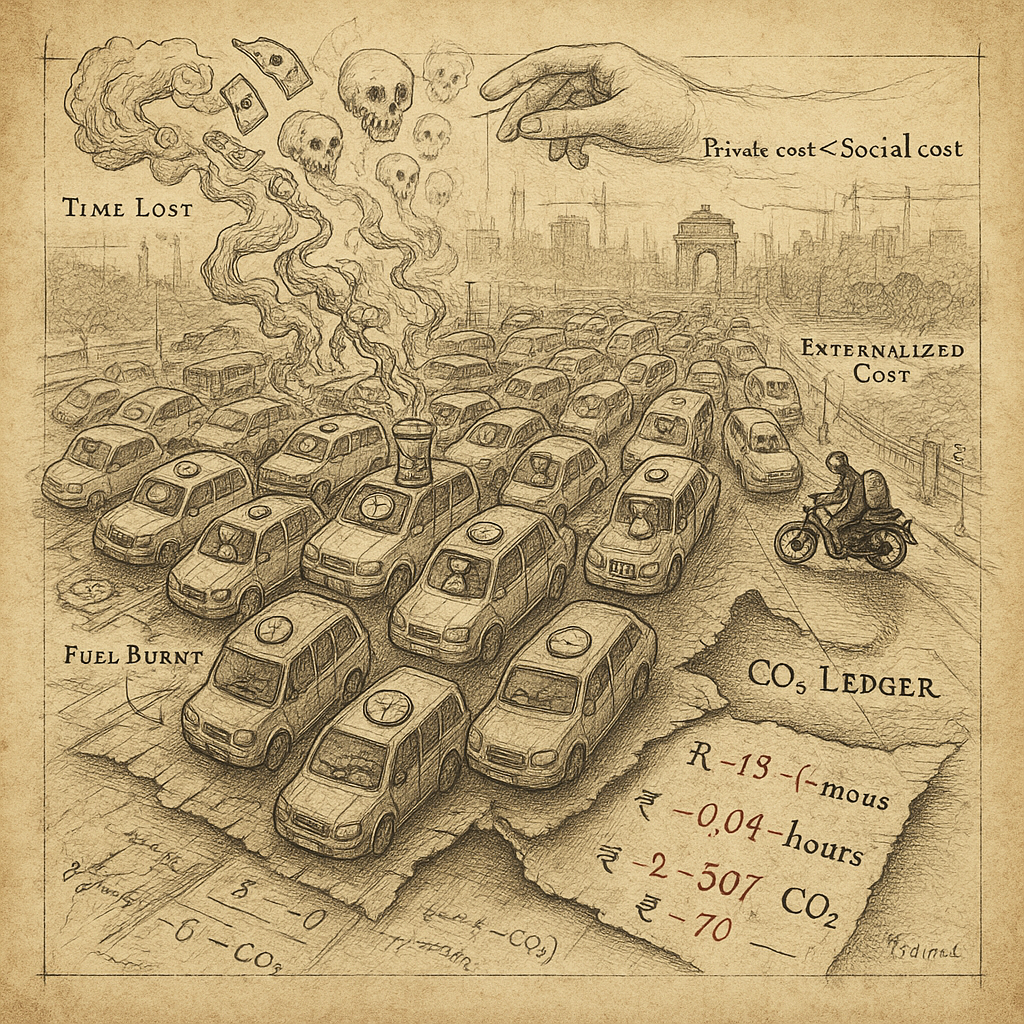“We’re not just stuck in traffic. We’re stuck in an economic loop of our own making — one that trades hours of life for a few kilometers of convenience.”
The Jam That Says It All
At 8:43 AM on a Tuesday morning in central Delhi, 200,000 vehicles came to a halt at the ITO intersection. No accident, no weather event — just the routine weight of too many cars on too little space. Engines idled, horns blared, commuters stared at their dashboards. By the time the flow resumed, over 100,000 man-hours were lost, ₹44 lakh worth of fuel was wasted, and 107 tonnes of CO₂ were released into the air — in just one section of one city.
This isn’t an outlier. It’s a systemic issue that plays out across Indian cities daily. The problem isn’t just mobility — it’s economics. And we need to start calling it what it is: a classic market failure.
What Makes Traffic a Market Failure?
In economics, a market failure occurs when individual decisions, made in a “free” market, lead to outcomes that are inefficient or harmful to society. In the case of urban traffic:
- Drivers only consider their personal cost (fuel, time) — not the delays or pollution they cause others.
- The road is free at the point of use, even at peak hours.
- No penalty exists for contributing to congestion, emissions, or wear-and-tear.
The result? Overuse. Inefficiency. Environmental damage. Lost productivity. All of which are borne by society, not the individual actor.
We’re Paying to Sit Still
Let’s put this in human terms. The average driver in Delhi spends 152 hours per year stuck in traffic — six entire days of their life. Mumbai’s congestion adds 20–24 extra minutes per 10 kilometers. Bengaluru, home to India’s tech backbone, loses ₹20,000 crore annually, including ₹7,000 crore in lost IT productivity alone.
This is not “normal.” This is value destruction at scale.
Across India’s top 4 metros (Delhi, Mumbai, Bengaluru, Kolkata), the annual cost of congestion is estimated at ₹1.47 lakh crore (~US$18 billion). That includes:
- Lost time
- Fuel wastage
- Higher logistics and delivery costs
- Increased wear on vehicles
- Declining air quality and public health burden
The Air We Breathe, the Price We Don’t Pay
Idle traffic doesn’t just waste time — it chokes our cities. In Delhi, vehicular emissions contribute up to 40–45% of PM₂.₅ levels during peak hours. A single congested day can spike pollution to 5–8× baseline levels.
A 2019 study by TERI estimated that India’s road transport sector is responsible for 12% of the country’s total CO₂ emissions, with congestion amplifying emissions per km dramatically due to stop-and-go driving.
And yet, these impacts are not factored into our fuel prices, tolls, or driving choices. This is what economists call an externality — a cost offloaded onto someone else (in this case, society at large).
Two Lives in the Jam
Rohit, a 28-year-old Swiggy delivery executive in Bengaluru, estimates he cancels 2–3 orders daily during peak hours. Not because he can’t find the restaurant — but because he can’t reach the customer in time. He makes less money, gets lower ratings, and still spends extra on fuel.
Ananya, a law student in Delhi, leaves home at 7:30 AM for a 9:00 AM class just 11 km away. She’s been late more than 30 times this year. “My attendance suffers. But it’s either that or start my day at 6 AM,” she says.
These are not isolated stories. They are structural outcomes.
Cities That Got It Right
This isn’t an unsolvable problem. Cities around the world have used economic tools to internalize externalities — charging drivers appropriately for the costs they impose on others.
Singapore
- Introduced Electronic Road Pricing (ERP) in 1998
- Real-time tolls adjust based on congestion levels
- Result: Traffic volumes dropped ~45% in city center
London
- Congestion charge in central zone since 2003
- Over 30% drop in peak-hour car use
- Raised revenue to invest in buses and cycling infrastructure
Stockholm
- Trialled congestion pricing, later made permanent
- Reduced traffic by ~22%, emissions by 14%
- Won public support after immediate, visible results
These cities didn’t just fix traffic. They reallocated road space, improved air quality, and reinvested in public goods. Most importantly, they acknowledged that the road is not a limitless resource — and priced it accordingly.
Why India Hasn’t Done It (Yet)
India has avoided congestion pricing for two reasons:
- Political sensitivity — taxing driving is often seen as anti-middle class.
- Infrastructure gaps — poor last-mile transit makes pricing feel punitive, not corrective.
But delaying action is no longer neutral — it’s actively regressive. The cost of doing nothing is rising faster than the cost of reform.
What India Can (and Must) Do
To correct this market failure, India must take bold, targeted steps:
1. Pilot Congestion Pricing in Key Corridors
- Start with CBDs (e.g., Connaught Place, South Mumbai)
- Use digital tolling, dynamic pricing
- Reinforce with public education and real-time data
2. Phase Out Fuel Subsidies and Introduce Carbon-Linked Taxation
- Make fossil fuel use reflect its climate and health cost
- Offer rebates or exemptions for electric and shared mobility
3. Reinvest in Mass Transit and Active Mobility
- Use congestion revenue to improve metros, bus fleets, cycling lanes
- Expand feeder services to underserved areas
4. Mandate Emission-Based Vehicle Restrictions
- Introduce clean air zones, restrict high-emission vehicles
- Encourage modal shifts with incentives
5. Design Roads for People, Not Just Cars
- Prioritize pedestrians, cyclists, and public transport
- Reclaim curb space from parking to mobility
Final Word: The Price of Inaction Is Higher
If we continue treating roads like limitless free goods, we will keep paying for that illusion — in fuel, in frustration, in lungs, and in lost growth.
India doesn’t need more flyovers. It needs a new economic lens for its cities — one that sees traffic as not just a flow problem, but a pricing problem.
It’s time to fix the failure. For the planet. For the economy. For the people trapped in motionless mobility every single day.
Next on Planet & Profit: Could India’s carbon market correct its other invisible costs? Stay with us.


Leave a Reply